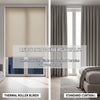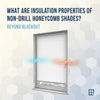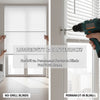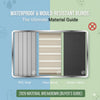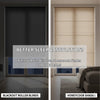The Hidden Impact of Window Treatments on Interior Design Psychology
- by Mariam Labadze
Quick Answer
Window treatments profoundly affect psychological wellbeing through controlling natural light that influences mood, circadian rhythms, and perceived space dimensions. Light-filtering options create calm, welcoming atmospheres promoting relaxation and social connection, whilst blackout treatments support restorative sleep and focused work environments. Color psychology applies strongly—warm tones (beiges, creams) create cozy comfort, cool greys promote concentration, and whites maximize perceived spaciousness. Texture adds depth affecting emotional responses—smooth surfaces feel modern and efficient, whilst soft fabrics create comfort and warmth. Strategic treatment selection manages privacy anxiety, with appropriate coverage creating security and confidence. Pattern scale influences spatial perception—large patterns make small rooms feel cramped whilst delicate designs expand perceived dimensions. Understanding these psychological principles transforms window treatments from purely functional elements into intentional design tools supporting mental wellbeing and daily life quality.
Light Control and Emotional Wellbeing
Natural Light's Psychological Power – Sunlight exposure directly affects serotonin production—the neurotransmitter regulating mood, social behavior, and emotional stability. Rooms flooded with natural light through sheer or light-filtering treatments promote positive mood, reduce depression symptoms, and create energizing environments supporting productivity and social interaction.
Conversely, excessive uncontrolled brightness creates stress through glare, eye strain, and uncomfortable heat. The optimal approach involves adjustable treatments allowing modulating light levels throughout changing daily conditions—maximizing beneficial morning illumination whilst controlling harsh afternoon sun that creates discomfort rather than wellbeing benefits.
Darkness and Rest Quality – Complete darkness during sleep proves crucial for restorative rest affecting mental health, cognitive function, and emotional regulation. Blackout blinds in bedrooms create optimal sleep environments by eliminating external light disrupting circadian rhythms and suppressing melatonin production essential for deep sleep.
The psychological security of controlling darkness extends beyond pure biological sleep requirements. The ability to create complete privacy and darkness on demand provides emotional comfort—knowing you can retreat into darkness when needed creates psychological safety contributing to overall home comfort and stress reduction.
Seasonal Affective Considerations – Winter's limited daylight challenges mental health for millions experiencing Seasonal Affective Disorder. Strategic window treatment use maximizing scarce winter sunlight through sheer fabrics or fully opened blinds during precious daylight hours helps mitigating SAD symptoms whilst supporting circadian rhythm maintenance during dark months.
Summer requires opposite approaches—managing excessive light and heat preventing spaces from becoming uncomfortably bright or hot, creating stress rather than the comfort that appropriate light levels provide. This seasonal adaptability makes adjustable treatments psychologically valuable through supporting wellbeing across varying annual conditions.
Color Psychology in Window Treatments
Warm Colors Create Comfort – Beige, cream, taupe, and warm greys create psychologically welcoming environments promoting relaxation and social connection. These hues reflect light softly without harsh brightness, creating gentle atmospheres that feel inherently comfortable and inviting rather than stark or sterile.
Warm-toned treatments particularly suit living rooms, family spaces, and bedrooms where emotional comfort and relaxation prove paramount. The subtle color influence operates subconsciously, creating feelings without occupants consciously recognizing window treatments' contribution to overall room atmosphere.
Cool Colors Promote Focus – Grey, blue-grey, and cool neutrals create calmer, more focused environments supporting concentration and productivity. These colors suit home offices, study spaces, or areas designated for work requiring mental clarity without the cozy comfort that warm tones promote potentially encouraging relaxation over focused attention.
The psychological distinction between warm and cool tones proves subtle but measurable through occupant comfort reports and productivity assessments in workspace environments. Understanding these influences allows intentional color selection supporting specific room functions beyond pure aesthetic preferences.
White Maximizes Spaciousness – Pure white treatments create maximum light reflection and perceived spaciousness, making rooms feel larger, brighter, and more open. This expansion effect proves particularly valuable in compact spaces where every visual trick maximizing perceived dimensions improves psychological comfort preventing claustrophobic feelings.
However, excessive white sometimes creates sterile, clinical feelings lacking warmth. Balancing white treatments with warmer furnishings and décor elements prevents coldness whilst maintaining spaciousness that white window coverings contribute to overall spatial perception.
Bold Colors as Statements – Vibrant colored treatments create focal points and personality expressions that white or neutral alternatives cannot achieve. However, bold colors prove polarizing—what feels energizing and exciting to some creates overstimulation and visual exhaustion for others. This subjective response makes bold color choices appropriate for personal spaces reflecting individual preferences but questionable for shared areas requiring broad appeal.
Texture and Tactile Psychology
Smooth Surfaces Feel Modern – Sleek PVC, aluminum, or tightly woven fabrics create contemporary, efficient atmospheres that some personalities find appealing through association with cleanliness, order, and modernity. These smooth textures suit minimalist aesthetics and individuals drawn to streamlined, uncluttered environments.
However, exclusively smooth surfaces sometimes feel cold or unwelcoming to those craving textural variety and warmth. Balancing smooth window treatments with textured furnishings prevents environments from feeling too austere or impersonal.
Soft Fabrics Create Comfort – Textile window treatments introduce softness and warmth that hard surfaces cannot replicate. The visual and tactile softness creates subconscious comfort associations—spaces feeling more welcoming, relaxed, and residential rather than commercial or institutional.
Fabric treatments also provide acoustic benefits, dampening sound reflections that hard surfaces amplify. This subtle noise reduction contributes to psychological comfort in urban environments where external noise creates ongoing low-level stress affecting occupants even without conscious awareness.
Natural Materials Ground Spaces – Wood, bamboo, and natural fiber treatments connect interiors to nature, supporting biophilic design principles that improve psychological wellbeing through natural element incorporation. These materials create grounding effects—subtle psychological benefits from organic textures and patterns that evolution programmed humans finding comforting.
The trend toward natural materials in window treatments reflects broader wellness movements recognizing that human psychology responds positively to natural elements even in primarily artificial interior environments.
Privacy and Psychological Security
Control Reduces Anxiety – The ability to control visibility into personal spaces proves fundamentally important for psychological comfort. Ground-floor properties, homes overlooking public spaces, or urban accommodations with close neighbors create privacy anxiety that appropriate window treatments resolve, transforming uncomfortable exposure into secure, controlled environments.
This control extends beyond preventing actual observation—psychological comfort from knowing you can ensure privacy matters even when practically no one is watching. The security comes from control itself rather than purely from blocking specific viewing threats.
Vulnerability Without Coverage – Bare windows create psychological discomfort for most people, particularly during evening hours when interior lighting makes occupants visible to darker exteriors. This exposure vulnerability increases stress levels measurably, affecting relaxation abilities and overall home comfort despite conscious rationalization that actual observation risks remain minimal.
Graduated Privacy Options – The ability to modulate privacy levels through adjustable treatments provides psychological flexibility supporting varying needs. Sometimes complete privacy proves necessary, whilst other times maintaining natural light whilst preventing clear views proves sufficient. Treatments offering graduated control support psychological comfort across these varying requirements.
Spatial Perception Manipulation
Vertical Lines Increase Height – Vertical blinds, floor-to-ceiling curtains, or tall roman shades draw eyes upward, creating psychological impressions of increased ceiling height. This vertical emphasis makes rooms feel more spacious and grand despite actual dimensions remaining unchanged—purely psychological effect nonetheless improving perceived space quality.
Horizontal Elements Widen Spaces – Venetian blinds' horizontal slats or roman shades' horizontal folds create width emphasis, making narrow rooms feel broader. Understanding these directional influences allows strategic treatment selection supporting optimal spatial perception in rooms with specific proportion challenges.
Light Colors Expand Dimensions – Pale window treatments reflect light whilst receding visually, making windows and surrounding walls appear further away. This recession effect increases perceived room depth and overall spaciousness—valuable psychological benefit in compact homes where actual square footage cannot change but perceived spaciousness dramatically affects comfort.
Pattern Scale Affects Perception – Large bold patterns advance visually, making surfaces appear closer and rooms feel smaller. Delicate patterns or solid colors recede, expanding perceived dimensions. This pattern psychology applies across all interior design but proves particularly relevant for window treatments covering substantial wall areas where pattern choices significantly impact overall spatial perception.
Consistency and Psychological Comfort
Visual Cohesion Creates Calm – Coordinated window treatments throughout homes create visual harmony that subconsciously promotes psychological comfort. The ordered consistency suggests intentionality and care rather than haphazard accumulation, creating environments that feel thoughtfully maintained rather than chaotic or neglected.
Mixed treatment styles—venetians in some rooms, romans elsewhere, bare windows intermittently—create visual fragmentation that some personalities find unsettling. This discomfort operates subliminally but affects overall home satisfaction measurably according to environmental psychology research.
Appropriate Context Matching – Window treatments matching room functions and architectural styles create psychological coherence—everything feeling "right" even without conscious analysis. Mismatched treatments—ultra-modern blinds in traditional Victorian rooms or heavy curtains in minimalist spaces—create cognitive dissonance causing low-level psychological discomfort.
Control and Empowerment
Agency Over Environment – Automated or easily adjusted window treatments provide psychological benefits through environmental control. This agency—ability to modify surroundings matching preferences and needs—contributes to psychological wellbeing through empowerment and autonomy that helplessness or difficult manual control undermines.
Smart blinds particularly enhance this control sense, responding to voice commands or smartphone taps that require minimal physical effort. This effortless environmental mastery supports psychological satisfaction beyond pure convenience, tapping into fundamental human needs for environmental control.
Predictable Comfort – Automated schedules creating consistent daily light patterns support psychological stability through predictability. Morning light admission at consistent times supports circadian rhythm health whilst evening closure at regular intervals creates routine that many personalities find psychologically grounding and comforting.
Conclusion: Intentional Design for Wellbeing
Understanding window treatments' psychological impacts transforms them from afterthought additions into intentional design elements supporting mental health and daily comfort. Light control affecting mood and sleep, color influencing emotional responses, texture creating comfort or efficiency feelings, and privacy providing security all contribute meaningfully to how spaces feel and how occupants experience them psychologically.
This awareness allows approaching window treatment selection strategically—asking not just "what looks nice?" but "how will this affect how I feel in this space?" The answers guide toward treatments genuinely supporting wellbeing rather than purely satisfying aesthetic preferences that might accidentally undermine psychological comfort through unconsidered light, color, or privacy implications.
At 1 Click Blinds, we recognize that window treatments affect far more than appearances—they fundamentally influence how you experience your home daily. Our diverse range ensures finding solutions that support your psychological comfort alongside aesthetic preferences, creating environments where you feel genuinely comfortable, secure, and content.

